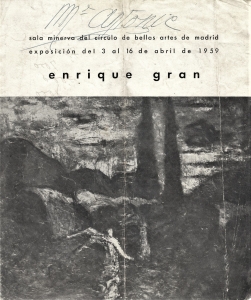ENRIQUE GRAN-PANCHO COSSÍO (1959)
First individual exhibition of Enrique Gran. Sala Minerva “Círculo de Bellas Artes”. Madrid.
Text for the catalogue of the exhibition Enrique Gran.
Minerva Gallery. Circle of Fine Arts, Madrid. April 1959.
It is difficult for a painter to write about another painter, and I have to do it today. May God lead us to confession! For this task, the painter, as a commentator, if he is sincere, should not beat about the bush, more or less literary, because he has no solvency in this field.
But he does if he limits himself to placing his writings in the orbit of the informative terrain, brief and true, like a common “missile”. Today we are living in a moment of crisis, which is very complex and very difficult to diagnose.
However, in this confusion, in which nothing is clear, the most essential points that motivate her are, I believe, somewhat clear.
And synthesizing to the limit – always insufficient limit – could very well be diagnosed in this way: Europe is tired of its culture, Europe is abandoning its culture.
And as the problem is arduous and analysis almost impossible, hence the characteristic style of art criticism, gassy, foggy, smoky, as the gases, clouds and fumes curl up in the typefaces and fill, like stagnant water, the spaces between lines, those spaces that are so eloquent to the attentive and astute reader.
So, in order not to follow the fashions of the last quarter of a century, let us dispense with the unravelling of the skein, let us call bread, bread and wine, wine, according to the use, custom and norm in every land of bread to carry that in something is esteemed.
Therefore, when I present Gran Madrid – the admiration and affection that I feel for it has prevented me from refusing to do so, and once and for all I will do so – I will abide by the line that I have drawn for myself, if that admiration and affection do not, together, play a dirty trick on me. And now we shall see what happens.
Enrique Gran Villagraz, of age, single, by profession: artist painter… -this is his municipal census sheet- is the consequence of a rich mixture of two nobles and noblemen: Aragonese and mountain people -this is his vital biochemistry-.
And this is how this great man is. And so he goes through life imbued with imaginary barracks and heraldic peaks – not in vain is he a mountain man – that proclaim his heroic destiny. And by dint of being twice a knight he is twice a poor man, a recidivism that makes his existence more dramatic.
I have just said that Gran is a heroic destiny, and because he is heroic there is no reason to fear that he will renounce his commitment to art in the face of society. And if the “cradle” did not give him a choice between opulence and necessity, the “bed” was already another song and opened up a wide range of elective possibilities before him.
And Gran, our Gran, was sparing in his choice: as a people he chose The Mountain, his mother’s little homeland – the mother always pulls the strings -, and as a profession, as the line of conduct of his life, painting. He did not choose any more. Thus, you have before you a mountain painter, a “Franciscan”, a loyal man to whom he gave his being.
Gran was a scholarship holder of the Provincial Council of Santander, which allowed our apprentice painter to enter the School of Fine Arts of San Fernando, where he studied all of his studies. Therefore, he is in possession of the official title that gives the official sufficiency.
And in this he is also faithful to a kind of mountain tradition: all of us (the mountain painters) have had a rigorous academic training; all of us, too, have broken with it, being guided in the new direction only by our individual and ideal pole star.
Thus, the Madrazo, founders of the mountain tradition, since it is not a school; thus, Casimiro Sainz, and Riancho, and Gutiérrez Solana, and María Blanchard (Gutiérrez Cueto at the baptismal font), and his nephew Quirós. Thus to Gran, passing through me, a disciple of D. Cecilio Pla, so admired and so remembered by me with emotion.
Finally, Gran is a man of his time, which does not mean that he is a crane that swallows all the millstones that the art magazines put in his mouth. Gran is too independent and free to submit to that servitude.
And this is possible because he has a great critical, introverted and extraverted sense; that is, he dispassionately sees and analyses his outer physical contours, as well as the abysmal depth of his subconscious. Gran is the man without physical or moral vices or defects, and he therefore derives from these gifts of Nature and from their austerity, as a whole, a moral conduct of the highest order.
At the same time, his behaviour as an artist is parallel to that of man. And it is very difficult to mount a propaganda of scandal against such a man, which is necessary today for a triumph without geographical boundaries.
However – I am a bombproof man of faith – I believe that goodness will prevail – your goodness – and your defeat will arrive in safe harbor. This is your moral compass. I put an end to it for fear of falling into the nebulosity that I censure.
Pancho Cossío
